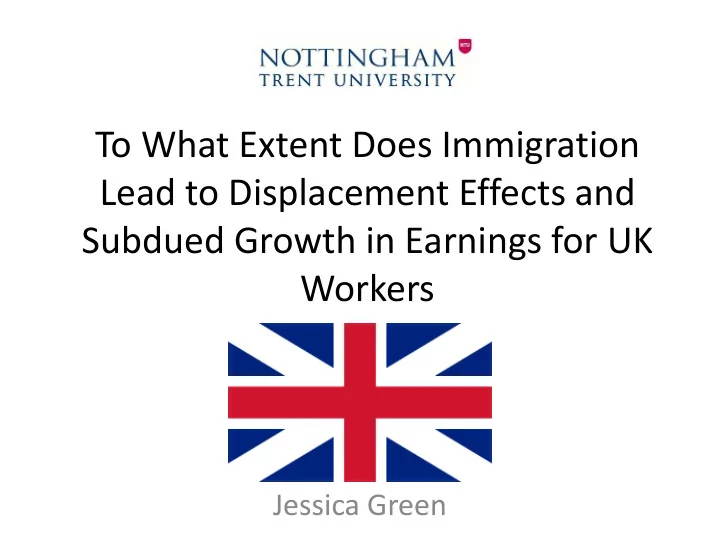

To What Extent Does Immigration Lead to Displacement Effects and Subdued Growth in Earnings for UK Workers Jessica Green
Introduction
Figure 1: Long-Term International Migration into and out of the UK 45% increase
What Migration is a dominant topic within public debate Why Why Lack of focus in Rising unemployment post public debate on the nature of labour recession yet historically high markets dominated levels of immigration by migrants How Shed light on the nature of ‘low paid, low skilled’ labour markets
Methodology
Literature Review Labour economic theory details the impacts on wages and employment from a supply side shock of immigration; wages fall whilst native workers are displaced. Dampening Displacement Of Wages Of Workers Small but positive effect Very little effect on native • • employment Negative impacts for the lower • end of the wage distribution Negative relationship between • Short immigration and native Small, negative impact overall, employment during periods of • Run with the effect being most negative growth evident for low skilled workers. Intermediate and lower skilled • experiencing the greatest effect
Research Questions • Does immigration lead to displacement of native workers; particularly for the lowest skill distribution i. group? • Does immigration lead to subdued growth in native wages; particularly for the lowest skill distribution ii. group? • Can immigration be solely responsible for the subdued growth in wages at the lowest skill distribution group? iii.
Methodology Time series analysis carried out over a 17 longitudinal period (2000-2016) which includes key policy decisions and macroeconomic factors, which may influence migration trends and labour market impacts. UK Employment Levels i) LFS Time Series Analysis UK Employment Rates – Skill Level i) OECD Time Series Analysis Skill-cell approach Median Earnings Levels – UK and Boston LFS Panal Analysis ii) ASHE ‘Low skilled, low pay’ Median Earnings Levels – Boston and five comparable regions LFS Spatial Analysis iii) ASHE ‘Low-skilled, low-pay’
Findings
Employment Levels by Nationality 32,000 196% 31,000 increase 30,000 29,000 Thousands ('000) 5% increase 28,000 27,000 26,000 25,000 24,000 2000 2001 2002 2003 2004 2005 2006 2007 2008 2009 2010 2011 2012 2013 2014 2015 2016 Employment Levels (UK born) Employment levels (Non-UK) Source: ONS, (2017c). ‘Labour Force Survey – Employment level nationality ’ , January 2000- December 2016 [accessed through ONS on 11/01/2017].
Employment Levels by Nationality Source: ONS, (2017c). ‘Labour Force Survey – Employment level nationality ’ , January 2000- December 2016 [accessed through ONS on 11/01/2017].
Employment Rates by Skill Level Source: OECD, (2017). ‘Employment rates by place of birth and educational attainment (25-64’ 2005-2015 [Accessed 10 th March 2017].
Nominal Median Earnings 2000-2016 600 50% increase 500 £ 39% increase 400 UK 300 Boston 200 100 0 2000 2001 2002 2003 2004 2005 2006 2007 2008 2009 2010 2011 2012 2013 2014 2015 2016 Source: ONS, (2017a). ‘Annual Survey of Hours and Earnings,’ 2000-2016 [accessed through NOMIS on 8/03/2017]
Median Earnings and Immigration Levels 2011 600 12000 500 10000 Immigration level 400 8000 Earnings (£) 300 6000 200 4000 100 2000 0 0 Boston Daventry Oadby and Wingston Corby Adur East Dorset Median Earnings Immigration Levels Source: ONS, (2017a). ‘Annual Survey of hours and earnings,’ 2000-2016, and ONS, (2017b) ‘Census 2011’ [accessed from NOMIS on 20/02/2017]
Median Earnings and Immigration Levels 2011 Source: ONS, (2017a). ‘Annual Survey of hours and earnings,’ 2000-2016, and ONS, (2017b) ‘Census 2011’ [accessed from NOMIS on 20/02/2017]
Conclusion
Conclusion Growth in employment levels; displacement effects difficult to prove • Boston identified as a ‘low-skilled, low-pay’ labour market; prone to slow growth in • earnings Five similar regions • Differing levels of immigration • Similar adverse effects from the recession • No clear indication that high immigration levels are associated with slow growth • in wages resulting from the EU enlargement The nature and characteristics of ‘low-pay, low-skill’ which attract migrants should be • considered as a key influencer in wage determination .
Future Research
Future research and Policy Recommendations • Outcomes of BREXIT • Incorporating non EU migration into analysis • Investment in training and education for low-skilled natives • Reviewing outcomes of policies for low-skilled workers
Thank You
Recommend
More recommend